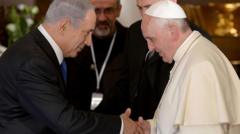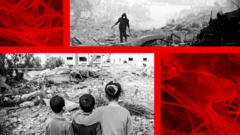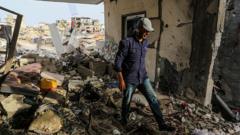After extended negotiations, Israel and Hamas have provisionally outlined a cease-fire deal that might lead to the release of hostages and Palestinian prisoners. While still needing formal ratification, key issues remain unresolved, with optimism tempered by underlying tensions and opposition.
Cease-Fire Outline Reached Between Israel and Hamas Amid Ongoing Conflict

Cease-Fire Outline Reached Between Israel and Hamas Amid Ongoing Conflict
Significant progress has been made in negotiations for a cease-fire in Gaza, as Israel and Hamas provisionally agree on a deal that could see hostages exchanged.
The aftermath of an Israeli strike in Gaza City on Wednesday continues to underscore the grim realities on the ground as both sides navigate the difficult path toward a cease-fire. Negotiators from Israel and Hamas have provisionally agreed to a cease-fire outline, although they have yet to finalize a start date and address several key technical issues, according to high-ranking officials involved in the mediation process.
The deal, which still requires approval from the Israeli cabinet, is intended to facilitate the release of Israeli hostages from Gaza in return for Palestinians detained in Israel. This potential agreement comes after more than a year of intense conflict that has resulted in substantial casualties and widespread destruction in Gaza. Despite the absence of an official endorsement from both parties, statements from Hamas indicated that negotiations were in their final stages. Israeli Foreign Minister Gideon Saar has also returned from an overseas trip to discuss the situation with his cabinet, reflecting the urgency of the discussions.
Key players in the negotiations include Egypt, the United States, and Qatar, with the latter facilitating talks in Doha. The sticking points of the agreement include the redeployment of Israeli forces within Gaza, ensuring the non-return of armed fighters to northern Gaza, and the organization of Palestinian prisoners set to be released as part of the deal. Reports indicate that Hamas officials are keen to finalize details shortly, though ambiguity remains regarding timing and what final approval entails.
Throughout the ongoing discussions, the absence of a final agreement highlights the complexities and sensitivities involved in the conflict. Opposition within Israel’s hard-line factions towards the deal poses additional challenges, although some cabinet members express a willingness to consider it. The negotiations mark a continuation of efforts that began in the wake of a surprise attack on October 7, 2023, which resulted in significant casualties and the capture of hostages. Previous attempts at establishing a cease-fire have stalled, with cautious optimism circulating among those involved.
The proposed cease-fire structure bears resemblance to a previous plan introduced by President Biden, suggesting a multi-phased implementation strategy that prioritizes humanitarian efforts alongside the exchange of hostages and prisoners. As both sides remain at a critical juncture, the implications of the ongoing talks could resonate far beyond the immediate conflict, potentially shaping the future of Israeli-Palestinian relations. The need for tangible solutions is urgent as negotiations continue to evolve in the face of fluctuating dynamics on the ground.
The deal, which still requires approval from the Israeli cabinet, is intended to facilitate the release of Israeli hostages from Gaza in return for Palestinians detained in Israel. This potential agreement comes after more than a year of intense conflict that has resulted in substantial casualties and widespread destruction in Gaza. Despite the absence of an official endorsement from both parties, statements from Hamas indicated that negotiations were in their final stages. Israeli Foreign Minister Gideon Saar has also returned from an overseas trip to discuss the situation with his cabinet, reflecting the urgency of the discussions.
Key players in the negotiations include Egypt, the United States, and Qatar, with the latter facilitating talks in Doha. The sticking points of the agreement include the redeployment of Israeli forces within Gaza, ensuring the non-return of armed fighters to northern Gaza, and the organization of Palestinian prisoners set to be released as part of the deal. Reports indicate that Hamas officials are keen to finalize details shortly, though ambiguity remains regarding timing and what final approval entails.
Throughout the ongoing discussions, the absence of a final agreement highlights the complexities and sensitivities involved in the conflict. Opposition within Israel’s hard-line factions towards the deal poses additional challenges, although some cabinet members express a willingness to consider it. The negotiations mark a continuation of efforts that began in the wake of a surprise attack on October 7, 2023, which resulted in significant casualties and the capture of hostages. Previous attempts at establishing a cease-fire have stalled, with cautious optimism circulating among those involved.
The proposed cease-fire structure bears resemblance to a previous plan introduced by President Biden, suggesting a multi-phased implementation strategy that prioritizes humanitarian efforts alongside the exchange of hostages and prisoners. As both sides remain at a critical juncture, the implications of the ongoing talks could resonate far beyond the immediate conflict, potentially shaping the future of Israeli-Palestinian relations. The need for tangible solutions is urgent as negotiations continue to evolve in the face of fluctuating dynamics on the ground.




















